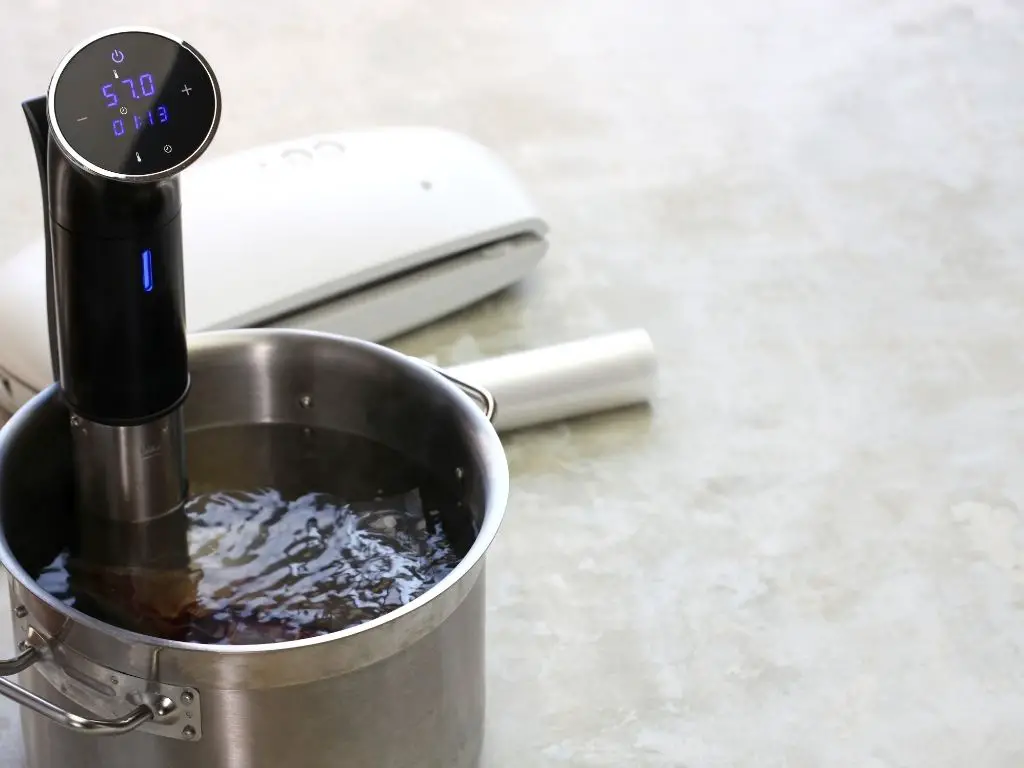Sous vide cooking involves sealing food vacuum-sealed plastic bags, then cooking the food in a precise, steady temperature water bath (immersion circulator). This low-temperature, long cooking time method results in food that is cooked evenly edge-to-edge without overcooking.
Sous vide enables precise control of cooking temperatures, which can be set significantly lower than normal cooking temperatures. For example, chicken is typically cooked to an internal temperature of 165°F, but sous vide chicken can be cooked as low as 141°F while still achieving food safety.
The vacuum sealed bags protect food from oxygen during extended cooking, minimizing oxidation and evaporative moisture loss. Food cooked sous vide tends to retain more nutrients and natural moisture and flavors compared to other cooking methods.

Sous Vide Products I Use Every Day
As an Amazon affiliate, I earn from qualifying purchases.
Last update on 2025-03-03 / Affiliate links / Images from Amazon Product Advertising API
Advantages of Sous Vide Cooking
1. Consistent Results
The precisely regulated water bath produces very consistent, repeatable results. Food cooks evenly throughout, eliminating issues like overdone outsides or undercooked centers. Sous vide ensures edge-to-edge doneness according to personal preference.
2. Enhanced Flavor and Texture
The low cooking temperatures enable connective tissues in meats to break down over extended cooking. This tenderizes tough cuts like brisket or shoulder. It also results in a silky texture for eggs and custards.
Cooking below boiling avoids moisture loss through evaporation. Foods retain natural juices and flavors instead of cooking away into the surrounding water or air.
3. Minimal Nutrient Loss
The gentle heat does not damage or degrade nutrients and vitamins. Food cooked sous vide shows less nutrient loss compared to high-temperature methods like grilling, frying, or boiling.
4. Time and Energy Efficiency
Once sealed, sous vide bags can be refrigerated for days before cooking. The water bath also gently brings food to temperature, requiring less energy than ovens or grills. Multiple items can be cooked simultaneously, streamlining meal prep.
Safety Concerns and Myths about Sous Vide Cooking
While properly performed sous vide cooking is safe, some common concerns about the method persist:
1. Plastic Leaching and Chemical Contamination
Cooking in plastic pouches raises fears of plasticizers, BPA, and phthalates leaching into food.
2. Food Safety and Bacterial Growth
The long, low-temperature cooking times seem risky in terms of foodborne pathogens. There are fears that cooking below 130°F encourages bacterial growth.
3. Nutrient Loss Due to Extended Cooking Time
Cooking meat or vegetables for 24 hours or longer seems likely to destroy vitamins or induce nutrient loss.
Debunking Myths and Addressing Safety Concerns
However, when performed properly, sous vide avoids the above issues:
1. Choosing the Right Type of Plastic Bags
The key is using food-safe, BPA-free pouches designed for sous vide. Most brands are made from polyethylene or polypropylene and do not contain plasticizers. When used once, there is minimal risk of leaching.
2. Proper Temperature and Cooking Time
While bacteria grows fastest between 40-140°F, sous vide temperatures keep food outside of that “danger zone”. Lower temperatures like 130-140°F are safe when combined with extended cook times that pasteurize food.
3. Vacuum Sealing and Food Storage
Vacuum sealing eliminates oxygen that could support bacterial growth. Sealed properly, food can be stored for several days before sous vide cooking.
Pasteurization occurs below boiling temperatures, given sufficient time. For example, beef requires holding 130°F for 112 minutes to achieve a 6.5-log10 relative reduction in E. coli bacteria.
Salmonella is inactivated in eggs held at 134-136°F for 69 minutes. Studies show minimal vitamin loss in vegetables even up to 15 hours sous vide.
Conclusion: Is Sous Vide Cooking Toxic?
When performed with care and proper technique, sous vide cooking is a safe method that offers advantages over other cooking styles. Using research-backed time and temperature guidelines is critical to pasteurize food. As with any cooking, starting with high-quality ingredients and maintaining diligent sanitation prevents illness.
Common myths about sous vide safety can be mitigated by:
- Choosing the proper BPA-free bags
- Understanding proper temperature and cooking time combinations to eliminate pathogens
- Using vacuum sealing and refrigeration to prevent bacterial growth during storage
- Adhering to food safety best practices – wash produce, avoid cross-contamination, and refrigerate promptly
Sous vide enables cooking food to the perfect level of doneness while retaining moisture, flavor, and nutrients better than other methods. While proper technique is important, there is nothing inherently toxic or dangerous about water bath cooking. With smart preparation and handling, sous vide cooked food can be completely safe and delicious.


![IMPRESA [10 Pack] Sous Vide Magnet Weights for Keeping Bags Submerged – Sous Vide Accessories to Stop Floating Bags & Undercooking – Weighted Magnets for Containers](https://m.media-amazon.com/images/I/41zHpl8G2lL._SL160_.jpg)

